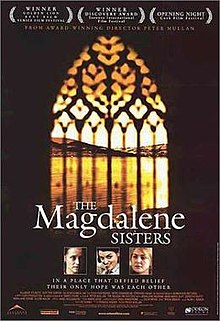Catching an Image
For three decades I’ve been passing the display window of a photographer in my neighborhood. He takes bad photos, and I have yet to find a good one in his window. My question is: can’t he take a good one by chance? Can’t his lens catch a good composition and channel it onto the film of his camera? The answer is no. Good artists are magicians, and bad ones have the magic of always being bad.
If by chance, he did take a good photo, he probably rip it up.

The Magdalene Sisters
In the film The Magdalene Sisters young girls, who are considered wayward for one reason or another, are committed to a Catholic asylum run by nuns. They are exploited as laundresses and forced to do other menial tasks without respite or pay. The word for this work is slave labor.
The sadistic Sister Bridget, a merciless taskmaster, or rather taskmistress, drives the girls to work harder and entertains herself by demeaning them.
In one scene, she announces a beauty contest and orders the girls to undress. The girl with thickest pubic hair will be declared winner. The honor goes to Crispina, who breaks down sobbing.
The film viewer is afforded the same pubic view as Sister Bridget. (Might as well provide a visual thrill for the male viewers while you’re engaged in social criticism!)
Later at a Corpus Christi celebration outside of the asylum walls, Crispina starts yelping and cannot made silent by the nuns.
She is then taken off to what must be an even worse asylum.

Churches and Temples
In my childhood I loved the Church, the lilting organ and the smell of incense. I loved the priests with their vestments and the nuns in their flowing habits. And I loved the wonderful illustrations of Jesus with the lamb and the children on the bridge with the guardian angel watching over them.
But there was one edifice that appealed to me as much as the Church, if not more, and that was “the Temple.” This building too was a “religious.” Its entrance was lit with flashing lights and there were long lobbies that led to caverns of worship.
Front-center were curtains that parted to reveal a screen that turned into a world of adventure with moving images in black-and-white or in color. And in the old days these Temples really resembled “Temples.” They not only resembled Temples, they were Temples.
Today the images are still shown in buildings with interiors that are bare auditoriums –
the Temples are gone.
I still have nostalgia for the Churches of my childhood. They still stand, but my attitude has changed; the Catechism has long lost its validity. So even though the old Churches still look the same, I see them through different eyes. But greater than my nostalgia for Churches is my nostalgia for the Temples of yore.

to be continued . . .
– Herbert Kuhner









 Users Today : 74
Users Today : 74 Users Yesterday : 165
Users Yesterday : 165 This Month : 2056
This Month : 2056 This Year : 18989
This Year : 18989 Total Users : 177084
Total Users : 177084 Views Today : 263
Views Today : 263 Total views : 1867498
Total views : 1867498 Who's Online : 6
Who's Online : 6




